 |
|
Israel Journal COLLEEN TINKER |
||||
NUMBER 3 — THURSDAY, OCTOBER 30, 2008
Ceasarea, Mt. Carmel, Megiddo, and Nazareth Village
Hi, everyone! We're at the Sea of Galilee tonight, and we're staying at Ceasar's right on the shore of the lake for two nights.
First, I want to tell you thank you again for your prayers. God has been so faithful. We have a lady in our group who's not from our church; she heard about this trip from her niece who attends Trinity, and she signed up at the last minute to go along. She requires a walker or, on more strenuous terrain, a wheelchair. She is assigned to Richard for his help and oversight. Today he had to push her on some pretty rough gravel paths—rough enough and uneven enough that a couple of guys helped in some spots by lifting the front of her chair by walking one on each side while Richard pushed. I was, as those of you who know me might imagine, pretty worried about his back…but when I whispered "How's your back?" he responded, "I have NO pain."
I can only thank God! He's not been pain-free, but he's doing well. Grace, you were right about the airport; Richard developed quite a soreness during all the stress and the subsequent sitting, but it's much better today!
We began our day with what, it turns out, is a legendary breakfast buffet at our hotel in Tel Aviv. The selection was awesome, but the really fun thing was that the foods all were unusual—seasoned and combined in uniquely Middle Eastern ways. From pastries to eggs and cheeses and fish and salads, everything was surprising and delicious. The cappuccino was familiar, though!
Ceasarea built by Herod the Great
We toured the ancient city of Ceasarea which Herod the Great (the one who killed the babies when Jesus was born) had built. We saw the foundation of his palace which had been built right out to the Mediterranean Sea, the remains of the beautiful aqueduct which had been in use when Jesus was here, and the recently discovered hippodrome Herod built with a sea view. (A hippodrome is a horse race course.) Another highlight was sitting in the recently excavated amphitheater which history had all but forgotten existed. Again, the amphitheater looks over the Mediterranean. Michael Hicks, one of our local FAF members, sang "It Is Well With My Soul" from the stage of the amphitheater. Awesome.
We saw the ruins of a Crusader city built over the area of part of Ceasarea; the entrance gate to the city is still standing, and it is beautiful with its vaulted ceiling. It's amazing that the arch, the aqueduct, and all sorts of civil-engineering-type-stuff was developed by Rome and continues to this day.
The really fascinating fact about Ceasarea, for me, is that Ceasarea is the city where Peter, after receiving his "sheet-of-unclean-animals-vision", met Cornelius, the centurion, and Peter went to Cornelius' home and preached to them. He and his household believed in Jesus and received the Holy Spirit. So, Ceasarea is the home of the first Gentile Christians. That's the city where OUR heritage began. It's really an awesome thought—and the city is in a breathtaking location on the coast of the Mediterranean Sea.
Mt. Carmel where Baal lost
We drove north to Mt Carmel—it's amazing how close together these famous places really are. Mt. Carmel, you remember, is the place where Elijah mocked the priests of Baal as they prayed for rain, and finally, after most of the day, Elijah built a new altar, drenched it with water, put the sacrifice on it, prayed, and God sent fire that consumed sacrifice, altar, and even the water on the ground—and then He sent the rain.
Mt. Carmel overlooks what is called the Jezreel Valley which is a huge, flat valley rich in agriculture today. From Mt. Carmel I could look across the Jezreel Valley and see the hill where Nazareth was built. Gary pointed out that from Nazareth, Jesus could see, for the 30 years he lived with his parents, the places where so many of the OT stories occurred. Also from Mt. Carmel we could see Mt. Tabor, reputed by many to be the site of the Transfiguration, and Mt. Moreh from where the Shunamite widow brought her dead son to Elisha, who was at Mt. Carmel, for him to raise from the dead—which he did. South of Mt. Moreh are the mountains marking the territory of Samaria. That whole area is also rich with biblical memories, but it is inaccessible today because it is part of the West Bank.
Of course, to the west of Mt. Carmel is the Mediterranean Sea. The whole place was beautiful—I was struck by how accessible these places are to each other. The Bible really did happen within a very small area; stories of the OT converge with stories from the NT—and all at the same places.
Gary talked about Israel's experience the day Elijah prayed for rain. He said they had a deep emotional experience when God did His miracles that day, but that visible demonstration of His power didn't change them into obedient followers.
Gary said, "A deep emotional experience is not a substitute for deep repentance. Israel had an experience but did not repent for their unbelief. The call to us is to stand against the Baals in our own lives. How are we being called to be faithful in our generation as we stand against the Baals in our lives?"
Megiddo and the last battle
We went to Megiddo for lunch. Megiddo is perhaps the oldest, most important trade crossroads of the ancient world. A big spring gave water at Megiddo, and, located as it is between Egypt and what is now Iraq (then Mesopotamia), it became a much-frequented stop as merchants traveled from Egypt to Mesopotamia. As years passed, the settlements built up around Megiddo would alternately die off and be rebuilt later.
The result is that archaeologists have discovered 21 layers of settlements at Megiddo—the most they have ever found in a tel. The really interesting thing about Megiddo is that it is the place we know as Armageddon. At Megiddo you can look north to Mt. Carmel, east to Nazareth, southeast to Mt. Tabor and Mt. Moreh, and south to Samaria—with the great plain of Jezreel spreading out in front of it. It's easy to see how the kings of nations could gather on this plain for a great battle—as, indeed, they did over and over through ancient history.
Whatever the final battle will "look" like, Megiddo is the same place often translated "Armageddon", and this is the place John mentions in Revelation.
Nathareth Village
The last place we went today was Nazareth. In 2000 a group of Christians opened a long-researched and carefully planned "Nazareth Village" which has recreated the essential elements of first-century life in Nazareth. They have built this village on a small area that apparently used to be the real farmland outside the original city of Nazareth. They have discovered in this small area the remains of ancient terraces, an irrigation system, and the winepress.
The village designers have planted a small olive grove and also have set up an authentic olive press (run by a donkey who literally turns the stone) and also presses for doing first, second, and third presses from the olive pulp created by the donkey and his stone. The village builders also recreated a couple of houses, interconnected by tiny passageways, and they have people who demonstrate the wool prep, spinning, and weaving of period cloth and products. In addition, they have a small herd of sheep from which they do gather wool, and their shepherd stands with them throughout the day. The village tour ended at the synagogue which has been designed to match synagogues of the same time period which still stand in a few small towns. It is like the synagogue in which Jesus stood in Nazareth and read from Isaiah, announcing that the Scriptures foretelling the recovery of sight for the blind, the release of the oppressed, and the proclamation of the year of the Lord’s favor were fulfilled in their hearing that very day (see Luke 4:14-30).
I found Nazareth Village to be one of the most evocative things I've seen. Perhaps because the building and setting were realistic, perhaps because so much care and attention had been given to making it "authentic", it was quite moving to see how Jesus would have lived.
Tomorrow we go out on the Sea of Galilee, and we'll eat Galilee fish for dinner. We're both moving toward recovering from jet lag, but I admit I'm still struggling to stay awake much of the day.
The tour guide at Nazareth Village said their goal is to help people see the land as "the fifth gospel". I understand what he means. Seeing the layout, how close things really are to one another, how feasible it would have been for Elijah or Peter or Paul to walk from place to place is remarkable. The Bible DID happen—and it all happened logically and in a three dimensional place that determined many of the details.
For example, the climate is very much like Southern California. Even the naturally-occurring vegetation in the areas with Mediterranean climate look like "home". The air temp is much like home for this time of year, also. Because of the warmth and dryness, Jesus and the apostles could have walked and even stayed outdoors much of the time. The parables He told were naturally-occurring scenarios from Everyone's perspective.
The Bible is real, and it happened in three dimensions with people like us participating in the events. And we can still walk on the ancient stones and see the same hills, valleys, and seas that they saw.
It's awesome being able to share these memories with you as they happen! I'm keeping you in my prayers as well.
Copyright 1999-2008 Graphics Studio, Redlands, CA USA. All rights reserved. Revised November 17, 2008. Use of this site and forum signifies your acceptance of the Terms and Conditions. Send comments and questions to formeradventist@gmail.com
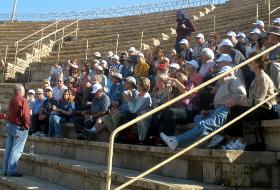
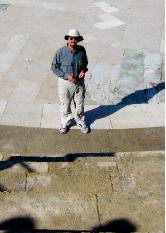
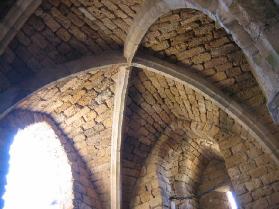
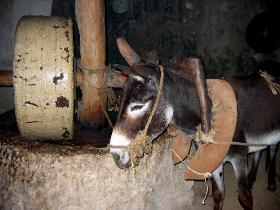
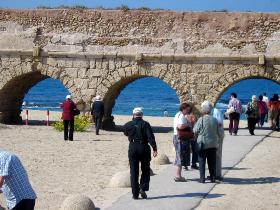 Roman aqueduct that supplied water to coastal cities in the time of Jesus.
Roman aqueduct that supplied water to coastal cities in the time of Jesus.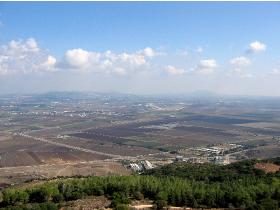 A view of the Jezreel Valley from Mt. Carmel.
A view of the Jezreel Valley from Mt. Carmel.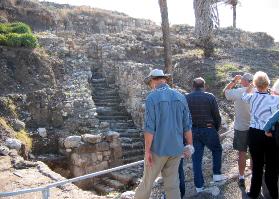 We walked through the ruins of Megiddo, one of the oldest and most important trade crossroads in the ancient world.
We walked through the ruins of Megiddo, one of the oldest and most important trade crossroads in the ancient world.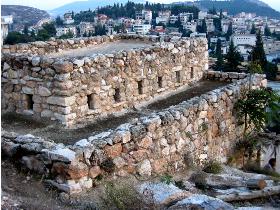 The recreated "Nazareth Village" house gave us an idea of what type of home Jesus lived in.
The recreated "Nazareth Village" house gave us an idea of what type of home Jesus lived in.